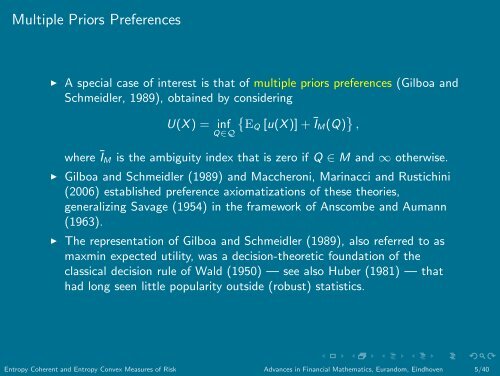Entropy Coherent and Entropy Convex Measures of Risk - Eurandom
Entropy Coherent and Entropy Convex Measures of Risk - Eurandom Entropy Coherent and Entropy Convex Measures of Risk - Eurandom
Variational Preferences ◮ A rich paradigm for decision-making under ambiguity is the theory of variational preferences (Maccheroni, Marinacci and Rustichini, 2006). ◮ An economic agent evaluates the payoff of a choice alternative (financial position) X according to U(X) = inf Q∈Q {EQ [u(X)] + α(Q)}, where u : R → R is an increasing function, Q is a set of probability measures and α is an ambiguity index defined on Q. Entropy Coherent and Entropy Convex Measures of Risk Advances in Financial Mathematics, Eurandom, Eindhoven 4/40
Multiple Priors Preferences ◮ A special case of interest is that of multiple priors preferences (Gilboa and Schmeidler, 1989), obtained by considering U(X) = inf Q∈Q¨EQ [u(X)] + ĪM(Q)©, where ĪM is the ambiguity index that is zero if Q ∈ M and ∞ otherwise. ◮ Gilboa and Schmeidler (1989) and Maccheroni, Marinacci and Rustichini (2006) established preference axiomatizations of these theories, generalizing Savage (1954) in the framework of Anscombe and Aumann (1963). ◮ The representation of Gilboa and Schmeidler (1989), also referred to as maxmin expected utility, was a decision-theoretic foundation of the classical decision rule of Wald (1950) — see also Huber (1981) — that had long seen little popularity outside (robust) statistics. Entropy Coherent and Entropy Convex Measures of Risk Advances in Financial Mathematics, Eurandom, Eindhoven 5/40
- Page 1 and 2: Entropy Coherent and Entropy Convex
- Page 3: Convex Measures of Risk ◮ Convex
- Page 7 and 8: Homothetic Preferences ◮ Recently
- Page 9 and 10: Variational and Homothetic Preferen
- Page 11 and 12: Question Rephrased [1] ◮ In other
- Page 13 and 14: Results [1] The contribution of thi
- Page 15 and 16: Results [3] ◮ These connections s
- Page 17 and 18: 2. Entropic Measures of Risk [1] We
- Page 19 and 20: Two Interpretations 1. Kullback-Lei
- Page 21 and 22: Entropy Coherence and Entropy Conve
- Page 23 and 24: Again Two Interpretations [2] The e
- Page 25 and 26: A Basic Duality Result Define and T
- Page 27 and 28: 3. Characterization Results [1] Rec
- Page 29 and 30: Remark 1 ◮ The case that ρ is en
- Page 31 and 32: Characterization Results [3] Recall
- Page 33 and 34: 4. Duality Results [1] Recall that
- Page 35 and 36: 5. Distribution Invariant Represent
- Page 37 and 38: 6.1 Risk Sharing ◮ Suppose that t
- Page 39 and 40: Portfolio Optimization and Indiffer
Multiple Priors Preferences<br />
◮ A special case <strong>of</strong> interest is that <strong>of</strong> multiple priors preferences (Gilboa <strong>and</strong><br />
Schmeidler, 1989), obtained by considering<br />
U(X) = inf<br />
Q∈Q¨EQ [u(X)] + ĪM(Q)©,<br />
where ĪM is the ambiguity index that is zero if Q ∈ M <strong>and</strong> ∞ otherwise.<br />
◮ Gilboa <strong>and</strong> Schmeidler (1989) <strong>and</strong> Maccheroni, Marinacci <strong>and</strong> Rustichini<br />
(2006) established preference axiomatizations <strong>of</strong> these theories,<br />
generalizing Savage (1954) in the framework <strong>of</strong> Anscombe <strong>and</strong> Aumann<br />
(1963).<br />
◮ The representation <strong>of</strong> Gilboa <strong>and</strong> Schmeidler (1989), also referred to as<br />
maxmin expected utility, was a decision-theoretic foundation <strong>of</strong> the<br />
classical decision rule <strong>of</strong> Wald (1950) — see also Huber (1981) — that<br />
had long seen little popularity outside (robust) statistics.<br />
<strong>Entropy</strong> <strong>Coherent</strong> <strong>and</strong> <strong>Entropy</strong> <strong>Convex</strong> <strong>Measures</strong> <strong>of</strong> <strong>Risk</strong> Advances in Financial Mathematics, Eur<strong>and</strong>om, Eindhoven 5/40



